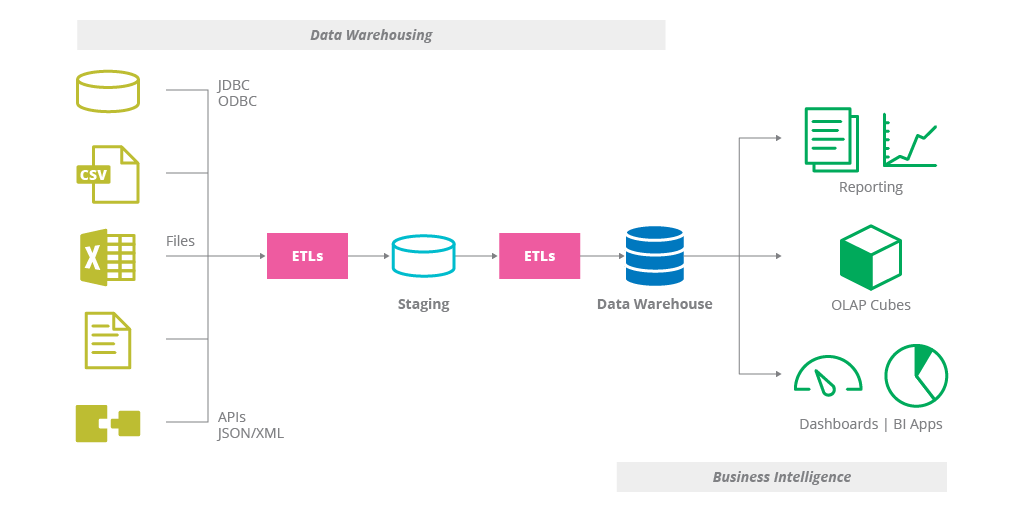
June 16, 2022
Big Data vs Data Warehouse: Key Differences, Comparison & Future Analysis (2025 Guide)
Author:

CEO & Co-Founder
Reading time:
8 minutes
Not so long ago, data warehousing was the buzzword among major organizations looking for an efficient means of data storage. A few years down the line and big data came into the picture, with some big industry players speculating that it could end up replacing legacy data warehouses.
However, when you look closely at big data and data warehouse technologies, you realize they share many similarities. For starters, both of them can hold huge amounts of data and can be used for reporting. This begs the question, how different are they, and could big data replace data warehouses in the future?
Find out more about our big data consulting services.
Let’s have a quick big data vs. data warehouse comparison.
What is big data?
Big data refers to a large volume of data that is too complex to be processed by traditional data processing databases and software. At its core, big data is characterized by volume, variety, and velocity, which Industry analyst Doug Lanely articulated in the early 2000s[1].

- Volume: Organizations collect data from numerous sources, including business transactions, information from sensors, and social media, among others.
- Variety: Collected data comes in all formats. It can be structured, semi-structured, or unstructured.
- Velocity: Recent technological advancements have allowed us to stream data at an incredible rate. Moreover, technologies such as sensors, smart metering, and RFID tags necessitate the need to process large volumes of data in real-time.
Big data architecture enables organizations to perform analytics on large volumes of data stored in various applications, regardless of its format.
What is a data warehouse?
A data warehouse is a collection of data from different heterogeneous sources. Data warehouses serve as a major part of business intelligence in most organizations. Data is gathered from various sources, transformed, and loaded into a repository where data analytics and management can be done to derive meaningful insights from the data [2].
To run business operations efficiently, companies use CRM applications and enterprise resource planning (ERP) to handle back-office functions such as finance, accounts receivable, accounts payable, supply chain, and general ledger, and front-office functions such as sales and call centers.

This data is stored in a structured format, and the databases are optimized for online transaction processing (OLTP) [3]. However, the databases cannot be easily queried for analysis and ad-hoc reporting, which gives them somewhat limited usability.
To circumvent this challenge, most companies previously used applications like Microsoft Excel. But, due to the limitations presented by the data’s freshness, integrity, and consistency, most organizations have gravitated from using Excel to perform analytics to more efficient business intelligence solutions.
They’ve also adopted the best practices that allow them to access and analyze data so they can gain meaningful insights that ultimately improve decision-making and streamline business processes.
Data Warehouse and Business Intelligence
The classic approach of providing business intelligence through collected data involves the extraction of data from various transactional systems and transferring it into a data warehouse.
This process typically starts with data consolidation tools such as Oracle Data Integrator or Informatica, which extract data from various sources, transform it into a usable format, and then transfer it into a final database such as a data warehouse.

Source: thoughtworks.com
Once the data is in the warehouse, organizations use rendering tools with prebuilt dashboards to access and pull data to derive insights into business performance or make data-driven decisions.
Although representations from traditional data warehouses are information-rich, they don’t address the changing variety of data that companies are accumulating to support their social e-commerce platforms.
This basically means that as organizations grow, they must look into other technologies that allow them to gain insights into data that is not stored on relational table sources.
Big data vs. data warehouse: What is the difference?
Technology vs. architecture
The most apparent difference when comparing data warehouses to big data solutions is that data warehousing is an architecture, while big data is a technology. These are two very different things in that, as a technology, big data is a means to store and manage large volumes of data.
On the other hand, a data warehouse is a set of software and techniques that facilitate data collection and integration into a centralized database. It also facilitates visualization, analysis, and tracking of key performance indicators on a dashboard.

Volume of data
Another major difference is that a data warehouse architecture is implemented on a single relational database that acts as the central store. However, big data solutions are meant to span multiple applications and handle big volumes of data, which in most cases, exceed the capability of any single application.
Usage os SQL queries
Additionally, a big data ecosystem typically includes a data warehousing service built on top of the solution’s core. These warehousing services include SQL, NoSQL, and SQL-Like data stores [4]. In contrast, most major organizations relying on data warehouses have gravitated to multiprocessor appliances to scale data volumes. Despite their effectiveness, these systems are very expensive, so they are out of reach for most small to medium-sized companies.
Structured vs. non-structured data input
In terms of data mining, big data takes all forms of data (unstructured, semi-structured, and structured) as input. On the other hand, data lakes only take structured data as input. Moreover, data warehouses use SQL queries to fetch data from a relational database, whereas big data doesn’t.
New data input
When new data is added to big data, the changes are stored in files, which are typically represented by tables. In a data warehouse, new data does not impact the data warehouse directly, making it difficult to gain real-time insights from new data.
Big data vs. data warehouse – final thoughts
Despite their apparent similarities, a closer look into big data and data warehouse technologies reveals that they are completely different in almost all aspects. The sheer volume of organizational data being generated, coupled with the need to provide real-time analytics and insights based on the data, has prompted many organizations to opt for big data solutions as opposed to data warehousing.
However, the answer to whether or not big data will replace data warehouses is yet to be seen, as both technologies and architectures are not interchangeable.
Big Data vs. Data Warehouse – FAQ
What is big data?
Big Data refers to a vast volume of data that traditional data processing software cannot manage effectively. It’s characterized by three main attributes: volume (the size of the data), variety (the type of data, including structured, semi-structured, and unstructured), and velocity (the speed at which data is generated and processed).
What is a data warehouse?
A data warehouse is a centralized repository for data collected from various sources. It is optimized for query and analysis, providing a coherent picture of business conditions at a point in time.
Can big data replace data warehouses?
While big data and data warehouses share some similarities, such as the ability to store large volumes of data and support reporting, they serve different purposes. Big data technologies are designed to handle vast amounts of complex data that exceed the capabilities of traditional data warehouses. However, data warehouses are still crucial for structured data analysis and reporting. The two technologies are not directly interchangeable, and the choice between them depends on specific business needs.
How do big data and data warehouses compare?
Big data solutions handle unstructured, semi-structured, and structured data and can process data in real-time. In contrast, data warehouses primarily deal with structured data and are optimized for batch processing rather than real-time analytics.
What are the key differences between big data and data warehouses in terms of data processing?
Big data technologies are capable of processing all forms of data, including unstructured and semi-structured, and support real-time analytics. Data warehouses, however, are built on relational databases and use SQL queries to fetch data, focusing mainly on structured data. Big data solutions can quickly adapt to new data, whereas data warehouses have a more static structure, making it difficult to incorporate real-time data changes.

Find out more about our big data consulting services.

This article is an updated version of the publication from Jun 16, 2022.
References
[1] Forbes.com. Big Data Definitions Consists of Three Parts not to be Confused With Three Vs. URL: https://www.forbes.com/sites/gartnergroup/2013/03/27/gartners-big-data-definition-consists-of-three-parts-not-to-be-confused-with-three-vs/?sh=94b9cff42f68. Accessed June 13, 2022
[2]Ws.org. URL: http://ceur-ws.org/Vol-256/submission_4.pdf. Accessed June 13, 2022
[3] Ibm.com. OLTP. URL: https://www.ibm.com/cloud/learn/oltp. Accessed June 13, 2022
[4]Towardsdatascience.com. SQL Vs NOSQL Database. URL: https://towardsdatascience.com/datastore-choices-sql-vs-nosql-database-ebec24d56106. Accessed June 13, 2022
Category:





